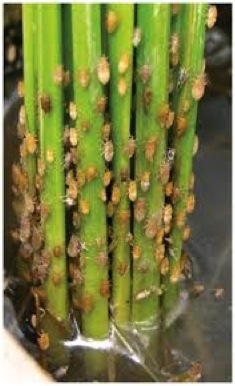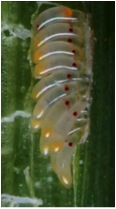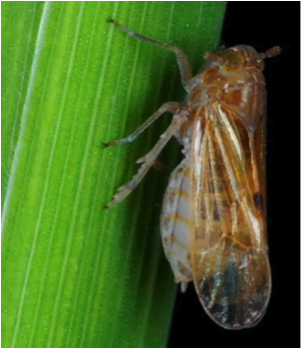| Brown plant leafhopper: Nilaparvata lugens |
Symptoms of damage:
- Nymphs and adults congregate at the base of the plant above the water level.
- Affected plant dries up and gives a scorched appearance called “hopper burn”.
- Circular patches of drying and lodging of matured plant.
- It transmits grassy stunt, ragged stunt and wilted stunt diseases.
- Honey dew is secreted by nymphs and adults which causes sooty mould at the base.
|
 |
 |
| Nymphs and adults at base of tiller |
Hopper burn |
Identification of insect pest:
-
Egg: Eggs are laid in a group of 2 to 12 in leaf sheath (near the plant base or in the ventral midribs of leaf blades). White, transparent, slender cylindrical and curved eggs are thrust in straight-line in two rows. (They are covered with a dome-shaped egg plug secreted by the female. Only the tips protrude from the plant surface).
-
Nymph: Freshly hatched nymph is cottony white, 0.6 mm long and it turns purple-brown, 3.0 mm long in the fifth instar.
-
Adult: Adult hopper is 4.5-5.0 mm long and has a yellowish brown to dark brown body. The adults exist in two forms, macropterous and brachypterous. Macropterous adults or long-winged have normal front and hind wings, whereas brachypterous forms or the short-winged have reduced hind wings. A prominent tibial spur is present on the hind leg.
|
 |
 |
| Eggs |
Affected Tillers |
.jpg) |
 |
| Winged Adult |
Adult Female |
Management:
ETL: 1 hopper/ tiller in the absence of predatory spider and 2 hoppers /tiller when spider is present at 1/hill.
- Avoid close planting and provide 30 cm rogue spacing at every 2.5 to 3.0 m.
- Control irrigation by alternate wetting and drying.
- Avoid excessive use of nitrogen
- Release of natural enemies like Lycosa pseudoannulata, Cyrtorhinus lividipennis adults (200-250 bugs/ha) during the peak incidence of BPH.
- Set up light traps during night or yellow pan traps during day time
- Drain the water before use of insecticides and direct the spray towards the base of the plants.
- Apply Neem oil 3% 6 lit/ac or Azadirachtin 0.03% 400 ml/ac
- Apply any one of the following insecticides
|
- Acetamiprid 20% SP 20-40 g/ac
- Acephate 75 % SP 400 g/ac
- Buprofezin 25% SC 320 ml/ac
- Carbosulfan 25 EC 400 ml/ac
- Chlorantraniliprole 18.5% SC 60 g/ac
- Chlorantraniliprole 0.4% G 4 kg/ac
- Clothianidin 50% WG 8-9.6 g/ac
- Chlorpyriphos 20 EC 500 ml/ac
|
- Dinotefuran 20% SG 60-80 g/ac
- Fipronil 5% SC 400 ml/ac
- Fipronil 0.3% GR 6.7 - 10 kg/ac
- Flonicamid 50% WG 60 g/ac
- Imidacloprid 17.8 SL 40-50 ml/ac
- Methyl demeton 25 EC 400 ml/ac
- Pymetrozine 50% WG 120g/ac
- Phosalone 35 EC 600 ml/ac
|
|





.jpg)
